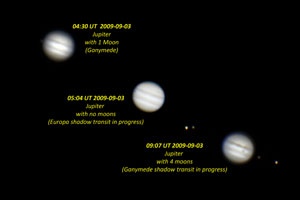 Three views of Jupiter before, during, and after the disappearing act by its four large moons. Credit, Conrad Jung, Chabot Space & Science CenterNow you see them, now you don't! Had Galileo spied the planet Jupiter with his telescope 400 years ago on a night such as a couple of Thursdays ago, would the history of modern astronomy have unfolded any differently? Would Jupiter's four large "Galilean" moons have been named so in his honor? Would we still think that everything revolves around the Earth?
Three views of Jupiter before, during, and after the disappearing act by its four large moons. Credit, Conrad Jung, Chabot Space & Science CenterNow you see them, now you don't! Had Galileo spied the planet Jupiter with his telescope 400 years ago on a night such as a couple of Thursdays ago, would the history of modern astronomy have unfolded any differently? Would Jupiter's four large "Galilean" moons have been named so in his honor? Would we still think that everything revolves around the Earth?
What am I talking about? About a week ago a relatively rare alignment of Jupiter and its four Galilean moons—Io, Europa, Ganymede, and Callisto—made for a brief time in which the moons disappeared, hidden behind and in front of their massive parent planet. For that brief time, Earth, Jupiter, and all four Galileans coincided on a nearly perfect line.
The event took place late in the evening on September 2nd, a little after 10:00 PM. Ganymede (the Solar System's largest moon) and Europa (the "snowball" with the probable deep liquid water oceans under its icy crust) crossed in front of Jupiter's disk, and the other pair, Io (the volcano moon) and Callisto passed behind it.
It's not uncommon for one of these moons to be out of view for a time when you aim a telescope at Jupiter. Even Galileo, on his first telescopic look at Jupiter, saw only three of them.
The disappearance of two or three of them at once is more rare, however, and a vanishing act by all four only happens a few times in a lifetime—every century, there are about 20 such alignments. The last such event prior to last week's was back in the 1980's; the next one won't happen until 2019. This event was not only observed on September 2nd by Chabot Space & Science Center astronomer Conrad Jung, but also in 1913 by then Chabot Observatory director Charles Burckhalter.
